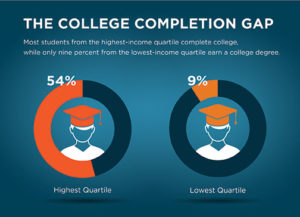
It was a new twist on the dreaded “work twice as hard to have half of what your peers have” mentality but it also seemed to just be an unfortunate reality in America.
But it isn’t often enough that the full picture of low-income students’ disadvantages is explored and unveiled to the very students who are trying to navigate that reality.
Many of these students do step up to the plate and work hard to obtain the type of academic scores that exceed expectations, but even that isn’t enough for them to overcome such daunting obstacles.
A 10-year study by the Department of Education that started in 2002 revealed that not only are low-income students often left struggling academically but even when they do excel in the classroom, their chances of obtaining a bachelor’s degree were still bleak when compared to their wealthy counter parts.
Even when wealthy students had average or below average scores, they still had a better chance of furthering their academic careers than low-income students who consistently earned stellar academic scores.
A vast majority of these low-income students did move beyond the high school halls to college campuses, but what happens after that is a often a disheartening tale.
“The problem is that most don’t finish, or settle for less than a bachelor’s degree, which of course limits their earning power later in life,” Slate’s Jordan Weissmann reported. “Sometimes they try to save money on tuition by attending community college, even though most two-year schools have a spotty track record when it comes to helping students graduate. Sometimes they get lost or overwhelmed in a college’s bureaucracy, because they don’t have educated parents who can help guide them along. Sometimes they try to work through school and simply can’t balance the demands of a job with their academics.”
Whatever the reason may be, even when low-income students do exactly what society has demanded of them—work harder than their peers in attempt to match their success—they are still slipping through the cracks when it comes time to earn a bachelor’s degree.
This eventually sets them up for economic disadvantages in the future and contributes to the ever-growing wealth gap that has been looming over America for far too long.

America’s top-notch, elite universities have the money and funding to open their doors to low-income students and help guide them to graduation but they rarely decide to do so.
A report by Insider Higher Ed revealed that while Harvard University has an endowment of roughly $43 billion, making it the wealthiest college in the country, it hasn’t dedicated a significant amount of funding to making sure intelligent low-income students have the opportunity to fill their prestigious halls.
The trend is the same for other wealthy and prestigious universities across the country.
“Yale University and the University of Notre Dame have $25.4 billion and $9.5 billion in cash and investments, respectively, but had the lowest portion of Pell recipients among this group, at 12 percent,” according to the report that took a closer look at the country’s 10 wealthiest universities. “Columbia University, with cash and investments of $9.9 billion, enrolled the highest number of Pell recipients, at 30 percent. Harvard, with its $43 billion in wealth, trailed behind at 19 percent.”
All the numbers are below the national average of 36 percent.
Since students that graduate from such universities often go on to earn more than their peers, the lack of low-income students being welcomed to such universities only works to widen the income gap.
And, based on the research reported by Inside Higher Ed, these universities aren’t interested in doing much about it.
“We are spending the most money as a society educating the wealthiest people,” Ronald Ehrenberg, director of the Cornell Higher Education Research Institute, told Inside Higher Ed. “The people who need help the most are the most disadvantaged. They end up going to the universities that spend the smallest amount per student.”
The result is an unfortunate and yet seemingly endless cycle that keeps low-income students trapped in poverty—regardless of whether or not they did manage to work twice as hard as their wealthy peers.


